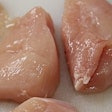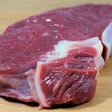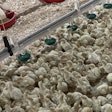Corn, soybean meal prices, as well as soybeans, exploded last month, and with little bearish news on the horizon for crops, egg producers will likely face huge feed input costs for months to come, if not longer.
In late December, March 2008 corn futures were above $4.50/bu., with deferred contract months over $4.70/bu. and even 2009 contracts well over $4.50/bu. January soybean futures, meanwhile were over $12/bu, with a $12-plus level for March through August. Soybean meal prices were equally high, $326/ton for January, with prices above $300 through September.
With corn, soybean and wheat prices at lofty levels, some temporary declines in prices might be expected, but there is little to suggest that prices will move significantly lower in the near term, Darrel Good, University of Illinois economist, said last month.
"More acreage of all three crops may be needed in the United States in 2008, and the prices of other crops are moving higher as well. In addition to more acreage, a favorable growing season is needed in 2008 to prevent another round of sharply higher prices," Good said.
Few Bearish Factors
"Typically," Good said, "there are both bullish and bearish market fundamental factors and the market must judge the net effect of those factors." But currently, "there are few bearish factors to weigh against the combination of strong demand and supply concerns."
The market also got a bump from last month's World Agricultural Supply and Demand Estimates (WASDE), released by USDA. The department lowered corn ending stocks for 2007-08 by 100 million bushels and raised the corn export forecast 100 million bushels on expected increases in foreign consumption and imports.
"At the projected 2.45 billion bushels, 2007-08 corn exports would be a record, surpassing the previous record of 2.4 billion in 1978-80," the report said.
USDA raised corn's season average farm prices to $3.35-3.95/bu., up 15 cents from its previous month's estimates, due to higher reported prices to date and higher cash and futures prices.
On soybeans, the WASDE report lowered soybean ending stocks for 2007-08 down 25 million bushels to 185 million, a 68 percent decline from 2006-07.
The department now projects the season average soybean price at $9.25/bu. to $10.25/bu., up 75 cents from the November report. One reason for the boost: a 20-million bushel increase in exports due to stronger-than-expected sales to China. Soybean meal prices, meanwhile, are forecast in the report at $265 to $295 per short ton for 2007-08, up $30 from the November report.
Major Factor: Ethanol
One major reason behind such high price forecasts is increased corn demand for ethanol, and if anything, ethanol use may rise further. Congress, for example, is considering legislation that would significantly increase biofuel mandates.
"While a cap on corn-based ethanol may be included in that legislation, the cap would be well above current levels of production," Good noted. "A cap of 15 million gallons, for example, would eventually require about 5.5 billion bushels of corn, compared to projected use for the current year of 3.2 billion bushels."
Good added that legislation being considered presumes heavily on the development of cellulosic ethanol technology that is economically competitive with corn-based ethanol. But if that technology is slow in developing, corn-based ethanol demand will remain very strong as long as crude oil prices are high.
A December Iowa State University report says that in the past two or three months, numerous articles in business and financial publications have indicated that the ethanol boom is about over.
"But just when many business writers were pronouncing an end to the rapid ethanol expansion, crude oil prices moved up by $30-35/barrel. High crude oil prices have been the primary driving force behind the ethanol expansion. The increased crude oil prices since late October have significantly improved ethanol-processing margins after a period of depressed returns in September and October. For some plants during the fall," the report continues, "returns were negative."
Slowed but not Halted Expansion
Last month's report says that "declining ethanol profit margins have slowed but not halted the expansion of the ethanol industry." Gross margins, the report says, "were considerably lower than at present from late 2001 to early 2003." Current margins are well below the 2006 level, however, when halting of MTBE production created an immediate large premium market for ethanol to improve air quality in certain densely populated areas.
The report notes than due to ethanol, total U.S. corn acreage increased by 20 percent in 2007 to the largest acreage since 1944, when soybeans were a minor crop. Sources of the increased corn acreage were a 29 percent decrease in cotton plantings, a 16 percent decline in soybean acreage, and an 8 percent decline in non-durum spring wheat, along with declines in plantings of several minor crops.
However, the report continues, "action in the soybean market indicates this shift of acreage to corn is not sustainable for the longer term unless soybean prices are much higher than in recent years." Record-high wheat prices likely have shifted a modest number of acres from corn and/or soybeans along the eastern edge of the Great Plains as well as in the eastern Corn Belt, Missouri, and the South. It is not clear yet whether the cotton market will buy back some of last spring's lost acreage.
More Soybean Acres
Kurt Guidry, economist at Louisiana State University, says cotton acres in his state are likely to remain low. In 2007, many acres shifted from cotton to corn, he says, and cotton prices are still weak "when you consider production costs." Looking at 2008, he expects more production shifts, but not as dramatic as in 2007. His prediction is that corn acreage will decline.
"When you look at the expense of growing a corn crop in comparison with what you have with a soybean crop, and the profitability looks the same, producers are going to choose the lower cost commodity, and that will be soybeans."
The Iowa report says that if all of the planned plants in Iowa are built, the volume of corn needed for the processing industry in the state will be 159 percent of the 2006 Iowa corn crop. That number does not include any requirements for corn for livestock feeding in Iowa, exports from the state for feeding and processing elsewhere in the United States, or exports to other countries.
The report says that traditionally, Iowa has been a major corn exporting state. "Some observers have concluded that Iowa will become a net corn importer within the next few years. However, a quick look at existing plants, as well as those under construction and being planned across the Corn Belt, suggests it will be difficult to find a sizeable source of corn for import."
The report says that just the plants currently being built in the United States, operating at rated capacity, will need the equivalent of about 60 percent to 66 percent of global corn exports. Most, if not all of these plants, should be operating within three years, and many will be in production before that. In addition, some portion of the 343 plants being planned but not yet under construction will likely start construction within the next three years. This rapid expansion of the industry is likely to put downward pressure on ethanol processing margins and will bring substantial changes throughout U.S. and global agriculture.



.jpg?auto=format%2Ccompress&fit=crop&h=167&q=70&w=250)
.jpg?auto=format%2Ccompress&fit=crop&h=167&q=70&w=250)













